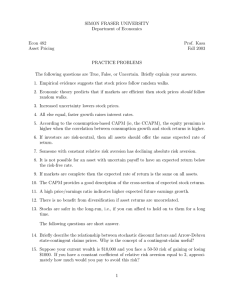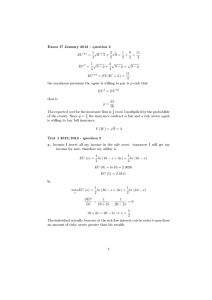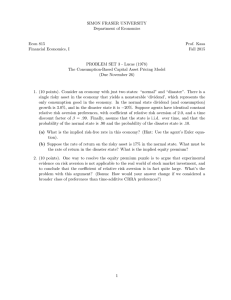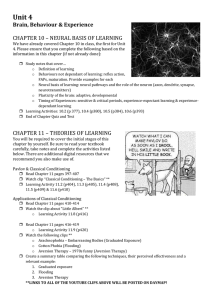Intergrating Economics and Biology for Bioeconomic Risk Assessment/Management of Invasive Species in Agriculture
advertisement
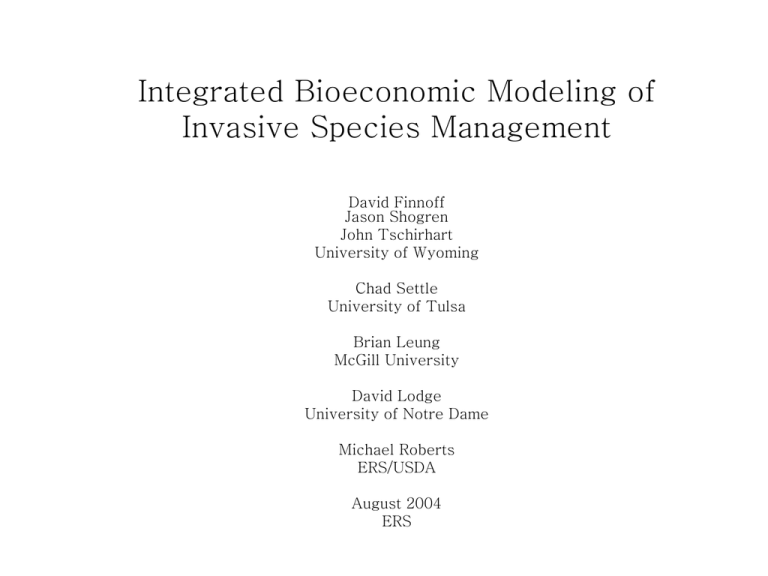
Integrated Bioeconomic Modeling of Invasive Species Management David Finnoff Jason Shogren John Tschirhart University of Wyoming Chad Settle University of Tulsa Brian Leung McGill University David Lodge University of Notre Dame Michael Roberts ERS/USDA August 2004 ERS • Progress—working toward integrating specific modeling approaches into one general framework • Application to leafy spurge Phase I: Endogenous Risk with discounting and risk aversion, Endogenous Risk • Captures risk-benefit tradeoffs • Stresses that management priorities depend crucially on: The tastes of the manager — over time and risk bearing The technology of risk reduction —prevention, control, and adaptation • Managers with different preferences will likely make different choices on the mix of prevention and control. Investigate how changes in a manager’s preferences over time and over risk affect the optimal strategy mix: 1. Explore comparative statics on how changing tastes affect the technology mix. 2. Implement the model to a specific application of managing zebra mussels in a lake. Schematic of the Invasion Process qH3 IH IH (1-qH3) q2 IL I p1 t=0 (1-q2) (1-p1) N t=1 p2 I (1-p2) N t=2 IL qL3 IH (1-qL3) IL IH q3 (1-q3) IL p3 I (1-p3) N t=3 Dynamic Endogenous Risk Stage 1: Stage 2: max St , X t P P P ˆ P (.) max U M D ( Z ; N ) C ( Z ) Z t t t t t t t t P Zt U t M t Dt ( ZˆtP ; Nt ) Ct ( St , X t , ZˆtP ); Et W ( Nt 1 ; ) qt 1 ( X t Nt )U t 1 M t 1 Dt 1 ( ZˆtP1; Nt 1 ) Ct 1 ( St 1 , X t 1 , ZˆtP1 ); EtW ( N t 1 ) pt 1 ( St ) 1 q ( X N ) U M C ( S , X , Zˆ P ); t 1 t t t 1 t 1 t 1 t 1 t 1 t 1 1 p ( S ) U M C ( S , X , Zˆ P ); t 1 t t 1 t 1 t 1 t 1 t 1 t 1 Comparative Statics – Risk Aversion Direct Effect Indirect Effect S EMBP MCP Wxx EMBC MCC Wsx H Direct Effect Indirect Effec X EMBC MCC Wss EMBP MCP Wsx H Simulation Results 1 Mean Annual Collective Prevention Mean Annual Collective Control 0.14 0.6 0.11 0.3 0.08 0.05 0 RN RA1 RA2 Risk Aversion RA3 RN RA1 RA2 Risk Aversion 0% 3% 0% 3% 5% 15% 5% 15% RA3 Simulation Results 2 Mean Annual Welfare Mean Annual Probability of Invasion 48 0.5 47.96 0.3 0.1 RN 47.92 RA1 RA2 Risk Aversion RA3 RN RA1 RA2 Risk Aversion 0% 3% 0% 3% 5% 15% 5% 15% RA3 Leafy Spurge Application Pop growth Biological data Env Factors Distr area/ population size Spread Study sites Prevention agency run expense Prevention cost Economic data Prevention effort expense Equipment, labor, employment, herbicide, etc. Control agency run expense Control cost Damage due to leafy spurge Control effort expense Equipment, labor, employment, herbicide, etc. Direct damage: husbandry Indirect damage: ecosystems impacts Conclusions • Explored how changes in a manager’s preferences for time and risk-bearing influence optimal strategy mix • Impacts are species-specific & rest on whether direct effects dominate the other through indirect effects • less risk averse managers who are far sighted, invest more in prevention, less in control, and require less private adaptation • Reduced risk aversion on the part of the manager yields lower probabilities of invasion, lower invader populations, and increased welfare • Risk aversion induces a manager to want to avoid risk—both from the invader and from the input used - go with the safer bet—control • More exploration into the underlying preferences of managers may be worthwhile to better understand how such effects might influence invasives management Phase II: General Equilibrium, Competition, & the Influence of Fundamental Resources GEEM Ri (eai e0 ) xi fi ( xi ) i dfi ( x) eai e0 0 xˆi dxi m Ni ai xi A eˆoi i 1 N t 1 1 Rˆi r N N [ ss 1] s r t t ˆi R Temperature ei e0 xˆ(ei , e0 , i ) 2i [(t ti ) 2 1] fi ( xi ; t ) i xi 2[(t ti )2 1] i xˆ 2 [( t t ) 1] i i 0.5 eˆ eai 2 ii [(t ti )2 1]0.5 ss i 0.5 ss 0 e0 b e01 R1 = 0 e0' a t' t1 t" t'" t Predictions 0.5 2 0.5 2 e 2( ) [( t t ) 1] e 2( ) [( t t ) 1] j i j j j i i i max SEL 400 350 300 250 200 150 100 50 2 1 4 1 Plant E(pi) 1 5 2 2 3 6 3 3 -2345 -1111 -2626 4 5 6 temperature 4 5 6 35 115 35 Invasion 1 250 7 Biomass, Plant 1 Biomass, Plant 2 6 200 5 150 4 100 3 2 50 Period 1 Period 0 1 5 9 13 17 21 25 29 33 37 41 45 49 200 0 1 5 9 13 17 21 25 29 33 37 41 45 49 T ~ U(min 0, max 6) Biomass, Plant 3 150 100 T ~ N(mean 3, st dev 0.75) 50 Period 0 1 5 9 13 17 21 25 29 33 37 41 45 49 Invasion 2 1000 Biomass, Plant 4 800 600 400 200 Period 0 1 5 9 13 17 21 25 29 33 37 41 45 49 1000 800 600 400 200 0 Biomass, Plant 6 Period 1 5 9 13 17 21 25 29 33 37 41 45 49 Biomass, Plant 5 (Invader) 1200 1000 T ~ U(min 0, max 6) 800 600 400 200 0 T ~ N(mean 3, st dev 0.75) Period 1 5 9 13 17 21 25 29 33 37 41 45 49 Humans Biomass Harvests 6 e6h xˆ 2 [( t t ) 1] 6 6 t 0.5 s 6 6 xˆ 2 cH 6[(t t6 ) 1]e s 6 e ea6 2 6 e6h [(t t6 ) 1] t 0.5 s 0 Herbicide 0.5 6 2 0.5 0.5 t eˆ ea6 2 6 6 [(t t6 ) 1] e 0.5 s 0 2 SEL P6 no harvests / herbicide P6 harvests / herbicide P1 P2 P3 P4 P5 Temperature tmin tmax 0.5 0.5( cH t ) Conclusions • Theory of plant competition based in individual plant physiological parameters and maximizing behavior • Theory starts prior to the population dynamics and builds on a behavioral basis • Captures redundancy in the plant community • Species with max expected valued of SS SEL parabola(s) are only non-redundant species • If invading species is non-redundant – it will dominate • Limitations o Only addresses resource competition o Omits mutualism & only considers mature plants & lacks age structure Phase III: Optimal Control Model Optimal Control • Determines Paths to Steady State under different scenarios, with: – no action by ranchers/farmers & land managers – action taken only by ranchers/farmers – action taken by both • Accounts for the impact of actions taken by ranchers/farmers • Flexibility to account for first-best path and welfare losses under second-best paths • Allows for economically viable and nonviable harvesting of invasive • Includes benefits/costs between steady states instead of simply a comparison of steady states Species Equations of Motion IS IS ( IS , CR, his , mis ) CR CR(CR, IS , hcr ) Representative Rancher/Farmer MaxU (hcr (CR, Tcr ), his ( IS , Tis ); X ) s.t.Tcr Tis Tt Land Manager as a Social Planner T Max U (hcr (CR, Tcr ), his ( IS , Tis ); X )e rt dt 0 s.t. CR, IS , X , mis mx mt Invader Population Across Scenarios 45000 40000 35000 30000 25000 20000 15000 10000 5000 0 No Control No Land Manager Control Optimal Control Year 0 Year 20 Year 40 Year 60 Year 80 Native Population Across Scenarios 3000000 2500000 No Control 2000000 1500000 No Land Manager Control 1000000 Optimal Control 500000 0 Year 0 Year 20 Year 40 Year 60 Year 80 Conclusions • Illustrate how accounting for actions by ranchers/farmers and feedbacks affect predictions on species populations • Show how the various paths to a steady state are altered by activity/inactivity of each party • Explore optimal action by land managers given model assumptions Remaining tasks • Phase IV: Leafy spurge in Thunder Basin Grasslands • Phase V: Implications • Phase VI: “Supermodel” validation
